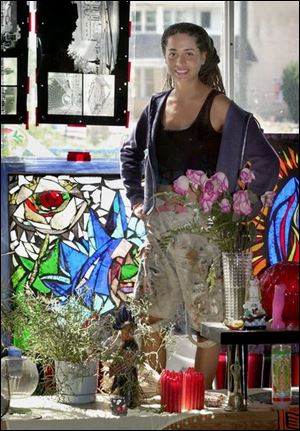
South Toledo activist loves her community
8/12/2002
`It really starts with artists, and people don't see that,' says Carmen Feliciana, in the front room of her Broadway gallery.
Carmen Feliciana seems to embody all the cliches of the hippie. She waxes poetic about guerrilla art and her hazy “visions” for what the future could look like, and offers to make you organic meals within an hour of meeting you.
But the proof of Carmen Feliciana's commitment - mosaics embedded in concrete, murals on walls and refurbished buildings in the “wrong” part of town - belie the stereotype.
Watching her sweep an arm to take in her neighborhood on Broadway, her vision suddenly seems possible.
Clad in jeans rolled up past the knee and a paint-splattered Tigers T-shirt, her hair in colorful braids, the 25-year-old self-described “professional volunteer” wants Toledo to be an artists' city.
She's convinced that in 20 years, Toledo will be like her favorite parts of Los Angeles, her other home base.
Ms. Feliciana co-founded a nonprofit, Foundation 433, to serve as an umbrella organization for her social service interests, which include art workshops for kids, community gardens, and an art gallery and workshop space.
She also buys buildings at tax-delinquent auctions and turns them into the kind of public spaces she thinks Toledo needs.
“If you have a space, things are going to happen,” she said. “Otherwise we'd just be a group of people saying we want to do something.”
A lot is happening at two buildings on Broadway. One of them, at 1226 Broadway, looks like a barn on the outside. But inside, the rooms are all different sizes, shapes, and conditions. Some rooms have been painted and cleaned; in others, plaster has fallen off in large patches.
In the front room, Bennett McPeck, 27, drapes cloth from a Nigerian artist onto a display. In the back, a Cuban sculptor shapes clay into finely sculpted heads. Both have flown into what Ms. Feliciana calls the “vortex” of her block on Broadway, along with donations of furnishings and “stuff” to fill the space.
The work isn't easy.
She makes regular trips around the neighborhood to re-appropriate equipment that's been stolen. Addicts sometimes wander into the building, and Ms. Feliciana, a slight woman who could pass for 16, chases them away.
“She'd run outside yelling at the 6-foot-tall crack heads,” said Mr. McPeck, the roommate who's working with her on her current project. “She said, `If you're going to be able to live here, you're going to have to stand tall.'”
Ms. Feliciana grew up in Toledo and California. Home-schooled, she showed an interest in business at an early age, so her parents enrolled her in business courses.
She bought her first building in Toledo from the rolls of tax delinquent property when she was 15, with money her great-grandfather left her because he had always recommended investing in property, she said. With family help, she started a small business, Back Alley Peddlers, in the building she bought on Dorr Street and outfitted local hipsters in clothes and Doc Martens for three years. In 1995, she liquidated the business to travel around Latin America.
Later, she bought 1224 and 1226 Broadway, a block where her mother also owns property.
Since she turned 19, she's lived in Latin America and Los Angeles, returning regularly to Toledo. When here, she works with neighborhood youth - making art, gardening - and seeding her vision.
City Councilman Louis Escobar met Ms. Feliciana through her involvement in the Latino community. He said her artistic vision fits into what the community hopes to bring to the area, and her “spark” and “vitality” impressed him.
“She's a breath of fresh air,” he said. “Whenever I leave after I talk to her, I always feel invigorated.”
Ms. Feliciana carries the genes of community involvement. Her mother, noted local Latino activist Maria Rodriguez-Winter, started taking her to meetings when she was a baby.
Mrs. Rodriguez-Winter helped found the Sofia Quintero Center and is vice chairwoman of the board of the Heritage South Commercial Revitalization Association.
Ms. Feliciana rented one of her buildings to the center for a symbolic fee, and served briefly as the center's executive director in 1999.
She's also made appearances on the boards of the Arts Council of Greater Toledo and the Heritage South Commercial Revitalization Association, but said she gets work done best outside of government structures.
“Politics takes too long,” she said. Instead, she prefers to paint and plaster, turning her cavernous rooms into a gallery of international crafts and local artists.
“It really starts with artists, and people don't see that,” she said. “You give an artist an opportunity, and they beautify an area.”